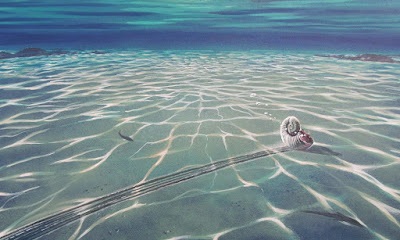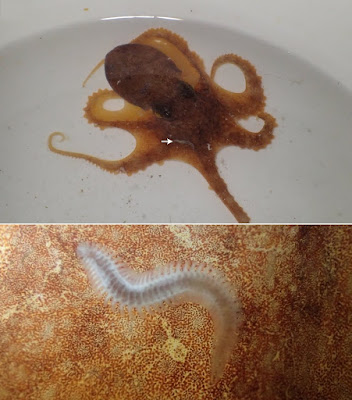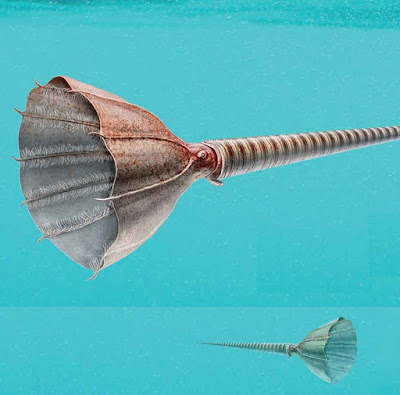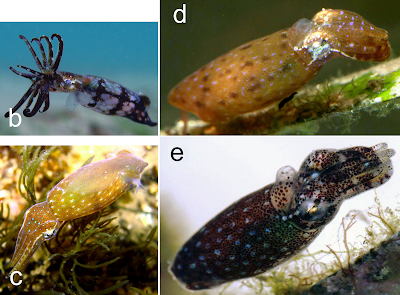Abstract
Trackways and tracemakers preserved together in the fossil record are rare. However, the co-occurrence of a drag mark, together with the dead animal that produced it, is exceptional. Here, we describe an 8.5 m long ammonite drag mark complete with the preserved ammonite shell (Subplanites rueppellianus) at its end. Previously recorded examples preserve ammonites with drag marks of < 1 m. The specimen was recovered from a quarry near Solnhofen, southern Germany. The drag mark consists of continuous parallel ridges and furrows produced by the ribs of the ammonite shell as it drifted just above the sediment surface, and does not reflect behaviour of the living animal.
| Fig 2. Various Plattenkalk localities of the Franconian and Swabian Alb. |
This exceptionally long fossil was produced by an ammonite shell post-mortem. The shell must have been partially buoyant, firstly because only a small portion of the shell contacts the substrate over the length of the mark, and secondly to be moved by a current that was gentle enough not to disturb the surrounding sediment. It is likely that the ammonite was losing buoyancy over the length of the drag mark, which resulted in eventual loss of all buoyancy and the ammonite falling on its side.
The drag mark of the studied specimen does not represent a mortichnion because it was not created by the animal when alive. Rather, this structure should more correctly be considered a tool mark. As such, behaviour must not be inferred from the drag mark of specimens such as MCFO 0492, and they have to be interpreted as non-biogenic structures produced by physical means. MCFO 0492 represents the hitherto longest fossil drag mark created by a dead animal, complete with the animal preserved at the end.
Dean R. Lomax, Peter L. Falkingham, Günter Schweigert and Alejandro P. Jiménez. 2017. An 8.5 m Long Ammonite Drag Mark from the Upper Jurassic Solnhofen Lithographic Limestones, Germany. PLoS ONE. 12(5): e0175426. DOI: 10.1371/journal.pone.0175426
Zombie ammonite from Jurassic Bavaria | Elsa Panciroli
theguardian.com/science/2017/may/11/zombie-ammonite-discovery-is-snapshot-of-an-unusual-moment-in-deep-time
theguardian.com/science/2017/may/11/zombie-ammonite-discovery-is-snapshot-of-an-unusual-moment-in-deep-time
---------------------------------------------------------------
روابط التحميل والمشاهدة، الروابط المباشرة للتحميل
او
شاهد هذا الفيديو القصير لطريقة التحميل البسيطة
كيف تحصل على مدونة جاهزة بآلاف المواضيع والمشاركات من هنا
شاهد قناة منتدى مدونات بلوجر جاهزة بألاف المواضيع والمشاركات على اليوتيوب لمزيد من الشرح من هنا
رابط مدونة منتدى مدونات بلوجر جاهزة بآلاف المواضيع والمشاركات في أي وقت حــــتى لو تم حذفها من هنا
شاهد صفحة منتدى مدونات بلوجر جاهزة بألاف المواضيع والمشاركات على الفيس بوك لمزيد من الشرح من هنا
شاهد صفحة منتدى مدونات بلوجر جاهزة بألاف المواضيع والمشاركات على الفيس بوك لمزيد من الشرح من هنا
تعرف على ترتيب مواضيع منتدى مدونات بلوجر جاهزة بآلاف المواضيع والمشاركات (حتى لا تختلط عليك الامور) من هنا
ملاحظة هامة: كل عمليات تنزيل، رفع، وتعديل المواضيع الجاهزة تتم بطريقة آلية، ونعتذر عن اي موضوع مخالف او مخل بالحياء مرفوع بالمدونات الجاهزة بآلاف المواضيع والمشاركات، ولكم ان تقوموا بحذف هذه المواضيع والمشاركات والطريقة بسيطة وسهلة. ــــــــــــــــــــــــــــــــــــــــــــــــــــــــــــــــــــــــــــــسلامـ.






















